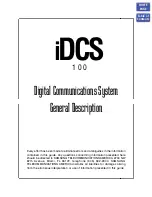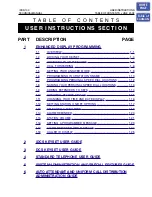
XEN Topaz
NEC Business Solutions Ltd
Features and Specifications Manual
Chapter 4 - 131
D
oc. N
o. 8846 -
Release
2.0
Apr
il 2005
step on to the next available member after the No Answer Step On Time,
timer 16-01-09. If the Department Group has Priority Routing enabled, and
the highest priority member is busy, the call will wait for the extension to
become free and will not step on to the next available member. Calls to the
group when all members are busy will receive ring back tone and wait for a
member to become free.
•
Busy & No Answer (Program 16-01-10 = 3)
A call to the pilot number will ring the first idle member of a Department
group, following the priority or circular routing. The call will continue to ring
the extension until it is answered or the calling party hangs up, it will also
step on to the next available member after the No Answer Step On Time,
timer 16-01-09. If the Department Group has Priority Routing enabled, and
the highest priority member is busy, the call will step on to the next available
member and continue to step on after the No Answer Step On Time. Calls to
the group when all members are busy will receive ring back tone and wait
for a member to become free.
Note that enhanced hunting will effect the operation of simultaneous ringing and
maximum queue limit.
Queue Announcements
If a call in queue is an outside call, and the system has DSPDB daughter board
installed for VRS, the queued caller can hear a customer recorded announcement.
Up to two different announcements can be given to the queued caller.
There is also a pre-recorded announcement, "Please hold on. All lines are busy. Your
call will be answered when a line becomes free."
The queue announcements are assigned by Program 22-15 for each group.
Note, DDI calls will not receive the queue announcement if the queue limit is set to 0 in
Progam 16-01-08, enhanced hunting is set to normal hunting in Program 16-01-10 and
the DDI has no transfer set in Program 22-11-05 as calls will not queue at the busy
group. You must set either a queue limit greater than 0 or set enhanced hunting to
allow calls to queue at a busy group or set a transfer option in 22-11-05.
User Log In/Log Out
An extension user can log out and log in to a Department Calling Group. By logging
out, the user removes their extension from the group. Once logged out, Department
Calling bypasses their extension. When they log back in, Department Calling routes to
their extension normally. All users can dial a code to log in or log out of their
Department Calling Group. A system phone can optionally have a function key
programmed for one-button log in and log out operation.
Secondary Group Allocation
An extension can be a member of one Department Group by allocation in Program 16-
02-01. An extension can also be a secondary member of other Department Groups by
allocation in Program 16-03-01. Each Department Group can have up to 16 secondary
members.
When a Department Group contains a secondary member allocated in Program 16-03-
01 then the simultaneous ring option (automatic and manual) is not available.
















































